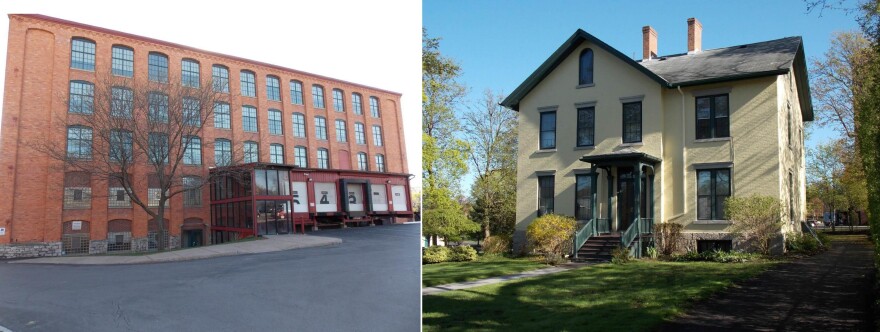Two Central New York properties were recently nominated to the State and National Registers of Historic Places. WAER News decided to dig a little deeper and find out what makes them historially significant.
A PIEMAKER'S DELIGHT
A Syracuse company known worldwide for its canned fruit and vegetables in the late 19th and into much of the 20th centuries might be long forgotten by many residents. But the nomination of the former Merrell-Soule mincemeat factory in Franklin Square to the State and National Registers of Historic Places might bring back some memories.
Curator of Museum Object Collection at the Onondaga Historical Association Tom Hunter says Lewis Merrell and Oscar Soule’s claim to fame was their None Such Mincemeat…
"In the 1880's, they developed a process to reduce the moisture content in traditional mincemeat, which originally included bits of meat and candied fruit. But today we know really know mincemeat more as candied fruit."

Hunter says much to the delight of bakers, this increased the shelf life of pies to be sold or consumed. The innovative process also made it possible to distribute the products across the country. Around the turn of the century, the company created powdered milk, which they called Klim, milk spelled backwards, and powdered eggs.
"They were able to ship these all over the world. Their Klim went to almost every continent...Europe, Asia, Africa. There was a major devastating earthquake in Japan in the early 1920's, and Merrell-Soule Company shipped tons of powdered milk to the survivors."

At its peak in the 1920’s, Merrell-Soule had 26 factories and 900 employees, with half working at its Syracuse plants. That’s also around the time the Borden Company bought most of the facilities and products. They expanded the Franklin Square facility in the late 50’s, then closed the plant when they shifted production to Pennsylvania in 1981, about a century after Merrell-Soule began operation. When Borden fell on hard times, JM Smucker bought the food lines in the early 2000's, and now owns and distributes what they call Borden None Such Mincemeat. Hunter with the OHA says the company’s website does trace the lineage and innovation back to Merrell-Soule Company.
"It's unfortunate that names become lost through dilution of mergers. But peeling away a few of the layers to reveal the origin of the products made by Merrell-Soule...it's something that should be recognized. It's extremely innovative."

The former factory is now a mixed use development. Hunter puts Merell-Soule’s contributions to the world in the same league as Smith-Corona typewriters, the Brannock foot measuring device, candles, medical equipment, pottery, and so much more that the Syracuse-area was known for in that era.
SEMINARY...AND UNDERGROUND RAILROAD STOP?
Ezra Huntington likely isn’t a household name, but back in late 1800’s Auburn, he certainly was. The late 19th century clergyman was a key leader of the Auburn Theological seminary, and his 1861 residence is awaiting approval for the National Register of Historic places.

As Steve Coleman tells it, he and his wife Judy really didn’t know the historical significance of the house when they bought it 30 years ago.
"We were in need of an office building, as a licensed psychologist myself. Then we formed a partnership with an occupational therapist who was also looking for office space. We bought the building, and shared it for many years."
The other therapist eventually moved on, and the Colemans kept the building. As the years went by, they learned more about Ezra Huntington.
"He taught for many years at the Auburn Theological Seminary, which trained Presbyterian ministers, apparently from around the world at one time. It was quite extensive grounds, like a campus, with plantings of trees and other things from around the world, honoring some of the students that came from all over."
But the property’s history might run deeper than its use as a seminary. Turns out it might have been a stop on the underground railroad.

"The seminary was known as abolitionist-oriented...anti-slavery. There is some documentation that freedom seekers were housed at the seminary grounds at one time. There's an unusual room off of the main attic that's not completely hidden, but its somewhat inaccessible, which we discovered after we bought the building."
Steve Coleman says SUNY Oswego Professor Emerita of History Judith Wellman told them the only likely purpose for the room was a shelter for freedom seekers. He says owning the house has been an exciting journey. The building was just approved last week for the State Register of Historic Places, and Coleman says that all but guarantees swift approval for the National Register.



